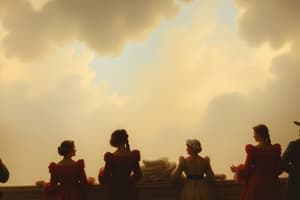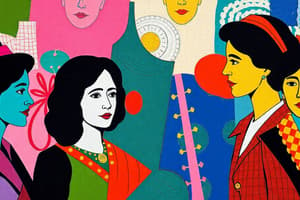Podcast
Questions and Answers
What was the main focus of the first wave of feminism?
What was the main focus of the first wave of feminism?
- Workplace equality
- Intersectionality
- Women's right to vote (correct)
- Access to contraception
What inspired the second wave of feminism?
What inspired the second wave of feminism?
- Vietnam War
- Civil Rights Movement (correct)
- Labor Union Movement
- Industrial Revolution
What was the focus of the second wave of feminism?
What was the focus of the second wave of feminism?
- Access to childcare
- Intersectionality
- Right to vote
- Workplace equality (correct)
What concept did the third wave of feminism focus on?
What concept did the third wave of feminism focus on?
When did the fourth wave of feminism begin?
When did the fourth wave of feminism begin?
What did the first wave of feminism achieve early in the 20th century?
What did the first wave of feminism achieve early in the 20th century?
What was the main concern of the second wave of feminism?
What was the main concern of the second wave of feminism?
Who organized the first U.S. convention on women's rights in 1848?
Who organized the first U.S. convention on women's rights in 1848?
Who played a significant role in both the women's suffrage and abolition movements?
Who played a significant role in both the women's suffrage and abolition movements?
Who is credited with initiating the second wave of feminism in 1963?
Who is credited with initiating the second wave of feminism in 1963?
Who was a key leader in the conservative women's movement, opposing the Equal Rights Amendment?
Who was a key leader in the conservative women's movement, opposing the Equal Rights Amendment?
Who coined the term 'intersectionality' in 1989?
Who coined the term 'intersectionality' in 1989?
Who aimed to maintain traditional female societal roles and opposed the Equal Rights Amendment?
Who aimed to maintain traditional female societal roles and opposed the Equal Rights Amendment?
Who believed that all institutions created by men were inherently oppressive?
Who believed that all institutions created by men were inherently oppressive?
What did the Seneca Falls Convention in 1848 advocate for?
What did the Seneca Falls Convention in 1848 advocate for?
Who organized the first U.S. convention on women's rights in 1848?
Who organized the first U.S. convention on women's rights in 1848?
Who is credited with initiating the second wave of feminism in 1963?
Who is credited with initiating the second wave of feminism in 1963?
Who coined the term 'intersectionality' in 1989?
Who coined the term 'intersectionality' in 1989?
Who was a key leader in the conservative women's movement, opposing the Equal Rights Amendment?
Who was a key leader in the conservative women's movement, opposing the Equal Rights Amendment?
Who believed that all institutions created by men were inherently oppressive?
Who believed that all institutions created by men were inherently oppressive?
What did the Seneca Falls Convention in 1848 advocate for?
What did the Seneca Falls Convention in 1848 advocate for?
Who opened the first birth control clinic in Brooklyn in 1916?
Who opened the first birth control clinic in Brooklyn in 1916?
When was the 19th Amendment passed, granting women the right to vote?
When was the 19th Amendment passed, granting women the right to vote?
Flashcards
First Wave Feminism
First Wave Feminism
A social and political movement that advocated for women's right to vote (suffrage).
Second Wave Feminism
Second Wave Feminism
A social and political movement that focused on achieving equality in the workplace and challenging traditional gender roles.
Third Wave Feminism
Third Wave Feminism
A social and political movement that expanded upon the second wave by recognizing the interconnectedness of various forms of oppression, particularly based on race, class, and sexual orientation.
Fourth Wave Feminism
Fourth Wave Feminism
Signup and view all the flashcards
Intersectionality
Intersectionality
Signup and view all the flashcards
Suffrage
Suffrage
Signup and view all the flashcards
Workplace Equality
Workplace Equality
Signup and view all the flashcards
Betty Friedan
Betty Friedan
Signup and view all the flashcards
Phyllis Schlafly
Phyllis Schlafly
Signup and view all the flashcards
Equal Rights Amendment (ERA)
Equal Rights Amendment (ERA)
Signup and view all the flashcards
Kimberle Crenshaw
Kimberle Crenshaw
Signup and view all the flashcards
Shulamith Firestone and Judith Brown
Shulamith Firestone and Judith Brown
Signup and view all the flashcards
Seneca Falls Convention
Seneca Falls Convention
Signup and view all the flashcards
Frederick Douglass
Frederick Douglass
Signup and view all the flashcards
1920
1920
Signup and view all the flashcards
Elizabeth Cady Stanton
Elizabeth Cady Stanton
Signup and view all the flashcards
Lucretia Mott
Lucretia Mott
Signup and view all the flashcards
Margaret Sanger
Margaret Sanger
Signup and view all the flashcards
Study Notes
Important Figures and Movements in Women's Rights
- Elizabeth Cady Stanton and Lucretia Mott organized the first U.S. convention on women's rights in 1848, leading to the first wave of feminism
- Frederick Douglass played a significant role in both the women's suffrage and abolition movements
- Betty Friedan's The Feminine Mystique is credited with initiating the second wave of feminism in 1963
- Phyllis Schlafly was a key leader in the conservative women's movement, opposing the Equal Rights Amendment
- Kimberle Crenshaw coined the term "intersectionality" in 1989, highlighting the compounded oppression faced by individuals due to intersecting aspects of their identity
- The conservative women's movement, led by Phyllis Schlafly, aimed to maintain traditional female societal roles and opposed the Equal Rights Amendment
- The radical women's movement, including Shulamith Firestone and Judith Brown, believed that all institutions created by men were inherently oppressive
- The Equal Rights Amendment, meant to guarantee equal legal rights regardless of sex, faced opposition and was never adopted into the U.S. Constitution
- The Seneca Falls Convention in 1848 marked a key milestone in the first wave of feminism, advocating for women's suffrage
- Margaret Sanger opened the first birth control clinic in Brooklyn in 1916, advancing women's reproductive rights
- The 19th Amendment in 1920 granted women the right to vote
- The FDA approved the first commercial birth control pill for women in 1960, further advancing women's reproductive rights
Studying That Suits You
Use AI to generate personalized quizzes and flashcards to suit your learning preferences.




